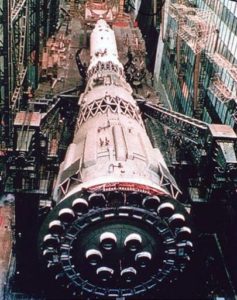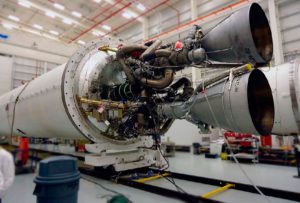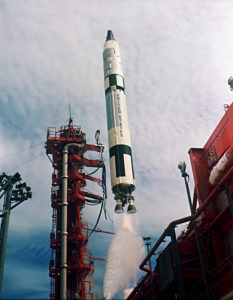No, I still can’t get past the insanity a few weeks ago on YouTube when I brought up the fact that the SpaceX booster has a large number of engines, and that increases the chance for something to go catastrophically wrong. To recap, not only did people get mad at me over even daring to say that something could go wrong (even though SpaceX has had 2 Falcon9 failures, one of which was on the pad! (more on that in the near future, by the way)) but also the fact that I dare make an even passive comparison to the Soviet N-1 booster, which failed in all 4 of its launched.

The N-1, showing its 30 first stage engines.
People complained to me that it was an improper comparison, since the N-1 could never be tested properly, let alone be properly assembled before shipping to the launch complex. It was all a damned mess, and whats worse, the flight control system simply couldn’t handle controlling all 30 of those 1st stage engines. Once one failed, everything went to hell, and the rocket was doomed.
This morning I took to reading on russianspaceweb.com about the N-1 and the NK-33 engines that powered its first stage. The site author wrote that the developers of the NK-33’s felt that while the N-1 itself was a terrible machine, as flown, due to inadequate testing and design flaws, their engines were of top quality, and they indeed have been proven to be, used in the new Soyuz 2-1v booster as well as the Antares rocket up until the October 2014 explosion. The new Antares will still use a Soviet engine design, but that’s another story for another time.

A pair of NK-33 engines.
Back to the SpaceX and that Interplanetary Transport System they propose, I still stand by my original statement that any given engine can fail, and that the more engines something has, the more likely at least one is to fail. That’s all my original statement was, and still all it stands at. I make no claim that the engines will fail, only that they can fail.
On the N-1, in one case, when an engine failed, it shut down nearly all of the 1st stage engines as a response, resulting in the booster crashing. In other launches, single engines exploded, destroying the craft (much like the Antares explosion in 2014). The entire thing was a mess that, while having many causes, still was made all the more probable by so many engines multiplying the chance for failure. If the computer can’t handle it, then everything goes to hell real quickly, doesn’t it?
Sure, the systems on the ITS that SpaceX is proposing will be top quality, I have no doubt on that. However, I still stand that the more parts you have, the greater chance something can go wrong, and I don’t care what kind of computer system you have, monitoring 42 engines is going to be quite the chore for it. It’s only a matter of time before something goes severely wrong.
People also argued with me, time and time again,t hat more engines means more redundancy, but even then, only a few engines would have to shut down before the booster could no longer complete its mission safely. That still doesn’t help you if one explodes, either, as I have said countless times at this rate.

Remember, nothing ever goes wrong with SpaceX rockets. They don’t explode on ascent, or even more embarrassingly on the pad, right?
Another thing worth noting about all these engines though is that the more modern boosters simplify things, and use far fewer engines, in many cases for simplicity sake. Look at the Soyuz 2-1v, mentioned earlier – instead of the normal core stage and strap on boosters, it uses a single core with only 2 engines, rather than the 4 thrust chamber monsters that the R-7 rocket family has used for 60 years now, to much greater effect.
You have to find a balance between redundancy, power, and weight. Many small engines weigh more, usually, than a single larger engine, or even a few engines larger than the many small ones. You would still get redundancy as well. Such worked with the Saturn V in both its 1st and 2nd stages, it worked well in the shuttle, and it works well in virtually every other “sane” rocket design in history.

The Saturn V Staging, in this case, showing both the 5 1st stage F-1 engines, as well as the freshly ignited 5 J-2 second stage engines. This rocket didn’t need 30+ engines to get to the moon, now did it? Even Mars booster variants would use only a few more engines to get the power they needed, if they had been built.
While I think the proposition of the ITS is far fetched on a whole, and will take many many years of effort and far more effort than even Apollo took, in application, I do see it as feasible. What I don’t see is what the SpaceX obsessed fans do, some perfect system that will never fail and will always succeed in its mission objectives. This simply won’t be the case. and something can, and by all logic, will happen. Murphy’s law, for sure, will catch up, and the more chances you give it to act, the more likely it is. That simple.
Funny how offended some people get when you say that, eh? Forgive my snark here, but seriously, getting as upset as people do over the simple mentioning of this design being risky is blasphemy to them. I would show the comments, but honestly, they aren’t something I want to dignify by sharing here.

I guess by their logic the Titan II was “unreliable” even though every Titan II GLV launched successfully without any major issue.
